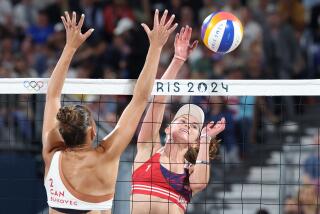Volleyball takes on a new look this...
- Share via
Volleyball takes on a new look this Olympics. Among other rule changes, players can now use their feet--or any other part of the body--to keep a ball in play. Both American teams are seeded fifth. In top form, the American women could be a threat to Cuba, which dominates the sport. The men’s team features only four players with Olympic experience.
At a Glance
Number of athletes: 144 men (12 teams), 144 women (12 teams).
Changes since Barcelona: Added four women’s teams.
Qualifications: Based on 1995 World Cup and qualifying tournaments.
Format: Four rounds of play; six-players teams.
Dates: July 20 to Aug. 4.
Locations: Omni Coliseum, UNiversity of Georgia.
Someone You Should Know
The best player on the world’s best women’s team is Mireya Luis Hernandez of Cuba. Once thought to be too small to be an effective hitter, Luis, 28, overcomes her modest 5-foot-8 stature with a 40-inch vertical leap.
On the men’s side, Italy, The Netherlands and Brazil, generally considered the top three teams in the world, all have go-to players at opposite hitter. Italy has Andrea Giani, The Netherlands Roelof Van der Meulen and Brazil Marcelo Negrao.
Mike Lambert, another opposite hitter, might be the most intriguing player to watch for the U.S. men.
Lambert, 22 and still with one year of eligibility remaining at Stanford, is the youngest member of the American team.
At the Net
Setting Dept
Normal set: When a perfect set 1.25 meters from the net meets the perfectly executed double block, the block can protect more than half the court. A team is able to form the double block only 20% of the time.
Deep: A set 2.0 meters from the net gives the attacker a greater target area.
What We Know
The U.S. men and women’s teams are medal contenders, yet, because of the depth of high-caliber competition, they will need to be clicking on all cylinders just to make it past the quarterfinal round.
Both American teams are seeded fifth. In international rankings, the men are ranked behind, in order, Italy, The Netherlands, Brazil and Cuba. The women follow Cuba, Brazil, South Korea and China.
Compared to the U.S. women’s team, which has eight former Olympians, the American men are new kids on the block. Only four players--outside hitters Bob Ctvrtlik and Scott Fortune, middle blocker Bryan Ivie and setter Jeff Stork--have past Olympic experience. Ivie and Ctvrtlik, the team captain, are starters.
In top form, the American women are perhaps the only threat to world champion Cuba, whose domination in volleyball is approaching that of which it enjoys in baseball.
The U.S. upset Cuba last summer at the Grand Prix in China, but since then the Cubans have been on a roll and the Americans have been inconsistent.
“It’s really Cuba and then a big gap and then everyone else,” said Aldis Berzins, a U.S. assistant coach. “They are physically way superior to any other team.
What We Don’t Know
In the men’s competition, which teams get hot might well depend on which players are executing their jump serves.
Two years ago, international rules were adopted to allow serving from anywhere beyond behind the endlines. Since then, it’s been bombs away.
Given more angles and room for airborne approaches, players are launching cannon-like service attacks with more speed, better movement and greater success.
Brazil’s Gilson Bernardo is said to hit the hardest of any player in the world. For the U.S., it’s 6-foot-8 setter Lloy Ball.
Something You Should Know
Soccer fans take note: Along with the change in serving rules came adjustments on what is allowed on defense. Open hands can be used on first touches and players now can use any part of their bodies--including their feet--to keep a ball in play.
Volleyball purists surely must cringe, but the rule changes have led to some spectacular saves. Instead of risking injury by tumbling head-first over scorers tables in pursuit of the ball, some players now stop and attempt to kick it back over their heads. If nothing else, the less stringent restrictions are popular with most fans because they lead to longer rallies.
The Moves
Play Calling
Hand signals are used to designate each play. Each play is written on a numbered system, which describes attack position. For instance, if an attacker was designated 32, he would spike the ball two feet above the net at position 3 on the court.
Net height:
Men-7’ 11 5/8”
Women: 7’ 4 1/8”
Serving
Variety: Each team prefers to have specialists who can serve the ball differently. A jump serve puts spin on the ball but travels in a predictable path. To counterattack the defender getting to the ball, it is served hard, causing mistakes. The Asian serve, shown at right, causes the ball to change direction, in midflight, and can be served more accurately.
The Asian serve: To acheive a floater serve that changes directions in midflight the ball must be spinless. The server’s body faces the target and his shoulders, arm and hand are in a line about 45 degrees to the floor. Contact must be with the exact center of the ball, otherwise there will be spin.
Sources: AP, Reuters, “Pass, Set, Crush Volleyball Illustrated” by Jeff Lucas.
More to Read
Go beyond the scoreboard
Get the latest on L.A.'s teams in the daily Sports Report newsletter.
You may occasionally receive promotional content from the Los Angeles Times.








